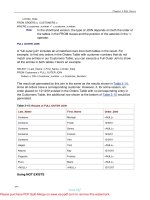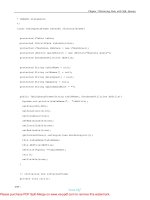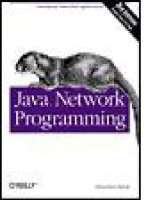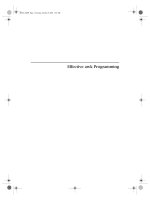Java Network Programming, 3rd Edition ppt
Bạn đang xem bản rút gọn của tài liệu. Xem và tải ngay bản đầy đủ của tài liệu tại đây (7.38 MB, 3,596 trang )
Java Network Programming,
3rd Edition
Table of Contents
Copyright
Preface
About the Third Edition
Organization of the Book
Who You Are
Java Versions
About the Examples
Conventions Used in This Book
Request for Comments
Comments and Questions
Acknowledgments
Chapter 1. Why Networked
Java?
1.1 What Can a Network
Program Do?
1.2 Security
1.3 But Wait! There's More!
Chapter 2. Basic Network
Concepts
2.1 Networks
2.2 The Layers of a Network
2.3 IP, TCP, and UDP
2.4 The Internet
2.5 The Client/Server Model
2.6 Internet Standards
Chapter 3. Basic Web Concepts
3.1 URIs
3.2 HTML, SGML, and XML
3.3 HTTP
3.4 MIME Media Types
3.5 Server-Side Programs
Chapter 4. Streams
4.1 Output Streams
4.2 Input Streams
4.3 Filter Streams
4.4 Readers and Writers
Chapter 5. Threads
5.1 Running Threads
5.2 Returning Information from
a Thread
5.3 Synchronization
5.4 Deadlock
5.5 Thread Scheduling
5.6 Thread Pools
Chapter 6. Looking Up Internet
Addresses
6.1 The InetAddress Class
6.2 Inet4Address and
Inet6Address
6.3 The NetworkInterface Class
6.4 Some Useful Programs
Chapter 7. URLs and URIs
7.1 The URL Class
7.2 The URLEncoder and
URLDecoder Classes
7.3 The URI Class
7.4 Proxies
7.5 Communicating with
Server-Side Programs Through
GET
7.6 Accessing Password-
Protected Sites
Chapter 8. HTML in Swing
8.1 HTML on Components
8.2 JEditorPane
8.3 Parsing HTML
8.4 Cookies
Chapter 9. Sockets for Clients
9.1 Socket Basics
9.2 Investigating Protocols with
Telnet
9.3 The Socket Class
9.4 Socket Exceptions
9.5 Socket Addresses
9.6 Examples
Chapter 10. Sockets for Servers
10.1 The ServerSocket Class
10.2 Some Useful Servers
Chapter 11. Secure Sockets
11.1 Secure Communications
11.2 Creating Secure Client
Sockets
11.3 Methods of the SSLSocket
Class
11.4 Creating Secure Server
Sockets
11.5 Methods of the
SSLServerSocket Class
Chapter 12. Non-Blocking I/O
12.1 An Example Client
12.2 An Example Server
12.3 Buffers
12.4 Channels
12.5 Readiness Selection
Chapter 13. UDP Datagrams
and Sockets
13.1 The UDP Protocol
13.2 The DatagramPacket
Class
13.3 The DatagramSocket
Class
13.4 Some Useful Applications
13.5 DatagramChannel
Chapter 14. Multicast Sockets
14.1 What Is a Multicast
Socket?
14.2 Working with Multicast
Sockets
14.3 Two Simple Examples
Chapter 15. URLConnections
15.1 Opening URLConnections
15.2 Reading Data from a
Server
15.3 Reading the Header
15.4 Configuring the
Connection
15.5 Configuring the Client
Request HTTP Header
15.6 Writing Data to a Server
15.7 Content Handlers
15.8 The Object Methods
15.9 Security Considerations
for URLConnections
15.10 Guessing MIME Content
Types
15.11 HttpURLConnection
15.12 Caches
15.13 JarURLConnection
Chapter 16. Protocol Handlers
16.1 What Is a Protocol
Handler?
16.2 The URLStreamHandler
Class
16.3 Writing a Protocol Handler
16.4 More Protocol Handler
Examples and Techniques
16.5 The
URLStreamHandlerFactory
Interface
Chapter 17. Content Handlers
17.1 What Is a Content
Handler?
17.2 The ContentHandler Class
17.3 The
ContentHandlerFactory
Interface
17.4 A Content Handler for the
FITS Image Format
Chapter 18. Remote Method
Invocation
18.1 What Is Remote Method
Invocation?
18.2 Implementation
18.3 Loading Classes at
Runtime
18.4 The java.rmi Package
18.5 The java.rmi.registry
Package
18.6 The java.rmi.server
Package
Chapter 19. The JavaMail API
19.1 What Is the JavaMail API?
19.2 Sending Email
19.3 Receiving Mail
19.4 Password Authentication
19.5 Addresses
19.6 The URLName Class
19.7 The Message Class
19.8 The Part Interface
19.9 Multipart Messages and
File Attachments
19.10 MIME Messages
19.11 Folders
Colophon
Index
index_SYMBOL
index_A
index_B
index_C
index_D
index_E
index_F
index_G
index_H
index_I
index_J
index_K
index_L
index_M
index_N
index_O
index_P
index_Q
index_R
index_S
index_T
index_U
index_V
index_W
index_X
index_Z
• Table of Contents
• Index
• Reviews
• Reader Reviews
• Errata
• Academic
Java Network Programming, 3rd Edition
By Elliotte Rusty Harold
Publisher : O'Reilly
Pub Date : October 2004
ISBN : 0-596-00721-3
Pages : 706
Thoroughly revised to cover all
the 100+ significant updates to
Java Developers Kit (JDK) 1.5,
Java Network Programming is
a complete introduction to
developing network programs
(both applets and applications)
using Java, covering everything
from networking fundamentals
to remote method invocation
(RMI). It includes chapters on
TCP and UDP sockets,
multicasting protocol and
content handlers, servlets, and
the new I/O API. This is the
essential resource for any
serious Java developer.
• Table of Contents
• Index
• Reviews
• Reader Reviews
• Errata
• Academic
Java Network Programming, 3rd Edition
By Elliotte Rusty Harold
Publisher : O'Reilly
Pub Date : October 2004
ISBN : 0-596-00721-3
Pages : 706
Copyright
Preface
About the Third Edition
Organization of the Book
Who You Are
Java Versions
About the Examples
Conventions Used in This Book
Request for Comments
Comments and Questions
Acknowledgments
Chapter 1. Why Networked Java?
Section 1.1. What Can a Network Program
Do?
Section 1.2. Security
Section 1.3. But Wait! There's More!
Chapter 2. Basic Network Concepts
Section 2.1. Networks
Section 2.2. The Layers of a Network
Section 2.3. IP, TCP, and UDP
Section 2.4. The Internet
Section 2.5. The Client/Server Model
Section 2.6. Internet Standards
Chapter 3. Basic Web Concepts
Section 3.1. URIs
Section 3.2. HTML, SGML, and XML
Section 3.3. HTTP
Section 3.4. MIME Media Types
Section 3.5. Server-Side Programs
Chapter 4. Streams
Section 4.1. Output Streams
Section 4.2. Input Streams
Section 4.3. Filter Streams
Section 4.4. Readers and Writers
Chapter 5. Threads
Section 5.1. Running Threads
Section 5.2. Returning Information from a
Thread
Section 5.3. Synchronization
Section 5.4. Deadlock
Section 5.5. Thread Scheduling
Section 5.6. Thread Pools
Chapter 6. Looking Up Internet Addresses
Section 6.1. The InetAddress Class
Section 6.2. Inet4Address and Inet6Address
Section 6.3. The NetworkInterface Class
Section 6.4. Some Useful Programs
Chapter 7. URLs and URIs
Section 7.1. The URL Class
Section 7.2. The URLEncoder and
URLDecoder Classes
Section 7.3. The URI Class
Section 7.4. Proxies
Section 7.5. Communicating with Server-
Side Programs Through GET
Section 7.6. Accessing Password-Protected
Sites
Chapter 8. HTML in Swing
Section 8.1. HTML on Components
Section 8.2. JEditorPane
Section 8.3. Parsing HTML
Section 8.4. Cookies
Chapter 9. Sockets for Clients
Section 9.1. Socket Basics
Section 9.2. Investigating Protocols with
Telnet
Section 9.3. The Socket Class
Section 9.4. Socket Exceptions
Section 9.5. Socket Addresses
Section 9.6. Examples
Chapter 10. Sockets for Servers
Section 10.1. The ServerSocket Class
Section 10.2. Some Useful Servers
Chapter 11. Secure Sockets
Section 11.1. Secure Communications
Section 11.2. Creating Secure Client Sockets
Section 11.3. Methods of the SSLSocket
Class
Section 11.4. Creating Secure Server
Sockets
Section 11.5. Methods of the
SSLServerSocket Class
Chapter 12. Non-Blocking I/O
Section 12.1. An Example Client
Section 12.2. An Example Server
Section 12.3. Buffers
Section 12.4. Channels
Section 12.5. Readiness Selection
Chapter 13. UDP Datagrams and Sockets
Section 13.1. The UDP Protocol
Section 13.2. The DatagramPacket Class
Section 13.3. The DatagramSocket Class
Section 13.4. Some Useful Applications
Section 13.5. DatagramChannel
Chapter 14. Multicast Sockets
Section 14.1. What Is a Multicast Socket?









